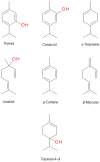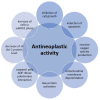Thymol and Thyme Essential Oil-New Insights into Selected Therapeutic Applications - PubMed (original) (raw)
Review
Thymol and Thyme Essential Oil-New Insights into Selected Therapeutic Applications
Adam Kowalczyk et al. Molecules. 2020.
Abstract
Thymol (2-isopropyl-5-methylphenol) belongs to the phenolic monoterpenes and mostly occurs in thyme species. It is one of the main compounds of thyme essential oil. Both thymol and thyme essential oil have long been used in traditional medicine as expectorant, anti-inflammatory, antiviral, antibacterial, and antiseptic agents, mainly in the treatment of the upper respiratory system. The current search for new directions of biological or therapeutic activities of natural plant substances with known structures includes thyme essential oil and thymol. Novel studies have demonstrated their antibiofilm, antifungal, antileishmanial, antiviral, and anticancer properties. Also, their new therapeutic formulations, such as nanocapsules containing these constituents, can be beneficial in medicinal practice and create opportunities for their extensive use. Extensive application of thymol and thyme essential oil in the healthcare sector is very promising but requires further research and analysis.
Keywords: new therapeutic applications; thyme essential oil; thymol.
Conflict of interest statement
The authors declare no conflict of interest.
Figures
Figure 1
Scheme of the key steps of thymol and carvacrol biosynthesis.
Figure 2
The structure of the main components of thyme essential oil.
Figure 3
Thymol metabolites.
Figure 4
Possible mechanism of antibiofilm action of thymol.
Figure 5
Possible mechanism of antifungal action of thymol.
Figure 6
Possible mechanism of antiviral activity of thymol.
Figure 7
Antineoplastic activity of thymol.
Similar articles
- Carvacrol-rich oregano oil and thymol-rich thyme red oil inhibit biofilm formation and the virulence of uropathogenic Escherichia coli.
Lee JH, Kim YG, Lee J. Lee JH, et al. J Appl Microbiol. 2017 Dec;123(6):1420-1428. doi: 10.1111/jam.13602. Epub 2017 Nov 2. J Appl Microbiol. 2017. PMID: 28980415 - Antibacterial Investigation of Thyme Essential Oil and Its Main Constituents in Combination with Tetracycline.
Miladinović DL, Ilić BS, Kocić BD, Ćirić VM, Nikolić DM. Miladinović DL, et al. J Med Food. 2015 Aug;18(8):935-7. doi: 10.1089/jmf.2014.0132. Epub 2015 Jan 19. J Med Food. 2015. PMID: 25599420 - Thymol, thyme, and other plant sources: Health and potential uses.
Salehi B, Mishra AP, Shukla I, Sharifi-Rad M, Contreras MDM, Segura-Carretero A, Fathi H, Nasrabadi NN, Kobarfard F, Sharifi-Rad J. Salehi B, et al. Phytother Res. 2018 Sep;32(9):1688-1706. doi: 10.1002/ptr.6109. Epub 2018 May 22. Phytother Res. 2018. PMID: 29785774 Review. - A Focused Insight into Thyme: Biological, Chemical, and Therapeutic Properties of an Indigenous Mediterranean Herb.
Hammoudi Halat D, Krayem M, Khaled S, Younes S. Hammoudi Halat D, et al. Nutrients. 2022 May 18;14(10):2104. doi: 10.3390/nu14102104. Nutrients. 2022. PMID: 35631245 Free PMC article. Review.
Cited by
- Thymol and carvacrol against Klebsiella: anti-bacterial, anti-biofilm, and synergistic activities-a systematic review.
Farhadi K, Rajabi E, Varpaei HA, Iranzadasl M, Khodaparast S, Salehi M. Farhadi K, et al. Front Pharmacol. 2024 Oct 24;15:1487083. doi: 10.3389/fphar.2024.1487083. eCollection 2024. Front Pharmacol. 2024. PMID: 39512827 Free PMC article. - Effects of Thyme (Thymus vulgaris) Essential Oil on Bacterial Growth and Expression of Some Virulence Genes in Salmonella enterica Serovar Enteritidis.
Hassanzadeh M, Mirzaie S, Pirmahalle FR, Yahyaraeyat R, Razmyar J. Hassanzadeh M, et al. Vet Med Sci. 2024 Nov;10(6):e70088. doi: 10.1002/vms3.70088. Vet Med Sci. 2024. PMID: 39474775 Free PMC article. - Toxicity of Common Acaricides, Disinfectants, and Natural Compounds against Eggs of Rhipicephalus annulatus.
Ibrahium SM, Abdel-Baki AS, Gadelhaq SM, Aboelhadid SM, Mahran HA, Al-Quraishy S, Reyad A, Kamel AA. Ibrahium SM, et al. Pathogens. 2024 Sep 24;13(10):824. doi: 10.3390/pathogens13100824. Pathogens. 2024. PMID: 39452696 Free PMC article. - A Review of Botanical Extracts with Repellent and Insecticidal Activity and Their Suitability for Managing Mosquito-Borne Disease Risk in Mexico.
Corzo-Gómez JC, Espinosa-Juárez JV, Ovando-Zambrano JC, Briones-Aranda A, Cruz-Salomón A, Esquinca-Avilés HA. Corzo-Gómez JC, et al. Pathogens. 2024 Aug 29;13(9):737. doi: 10.3390/pathogens13090737. Pathogens. 2024. PMID: 39338928 Free PMC article. Review. - Anatolian medicinal plants as potential antiviral agents: bridging traditional knowledge and modern science in the fight against COVID-19 and related viral infections.
Tilkat E, Jahan I, Hoşer A, Kaplan A, Özdemir O, Onay A. Tilkat E, et al. Turk J Biol. 2024 Jun 26;48(4):218-241. doi: 10.55730/1300-0152.2699. eCollection 2024. Turk J Biol. 2024. PMID: 39296335 Free PMC article. Review.
References
- Ghasemi G., Alirezalu A., Ghosta Y., Jarrahi A., Safavi S.A., Abbas-Mohammadi M., Barba F.J., Munekata P.E.S., Domínguez R., Lorenzo J.M. Composition, Antifungal, Phytotoxic, and Insecticidal Activities of Thymus kotschyanus Essential Oil. Molecules. 2020;25:1152. doi: 10.3390/molecules25051152. - DOI - PMC - PubMed
- Council of Europe . European Pharmacopoeia. 10th ed. Council of Europe; Strasbourg, France: 2019.
- European Medicines Agency Assessment Report on Thymus vulgaris L., Thymus zygis Loefl. ex. L., aetheroleum. [(accessed on 15 March 2020)]; Available online: https://www.ema.europa.eu/en/documents/herbal-report/final-assessment-re....
- European Medicines Agency Assessment Report on Thymus vulgaris L., Thymus zygis L., herba. [(accessed on 15 March 2020)]; Available online: https://www.ema.europa.eu/en/documents/herbal-report/final-assessment-re....
- Kosakowska O., Bączek K., Przybył J.L., Pawełczak A., Rolewska K., Węglarz Z. Morphological and Chemical Traits as Quality Determinants of Common Thyme (Thymus vulgaris L.), on the Example of ‘Standard Winter’ Cultivar. Agronomy. 2020;10:909. doi: 10.3390/agronomy10060909. - DOI
Publication types
MeSH terms
Substances
LinkOut - more resources
Full Text Sources
Other Literature Sources






